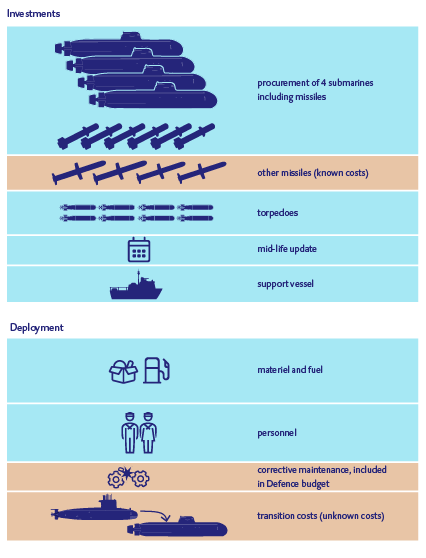Sights set on the replacement of submarines
The study phase reviewed
In 2016 the Minister of Defence commenced a new procurement project to replace its submarines. In December 2019, she informed parliament by policy letter of her intended decision. This is the Ministry of Defence’s largest new investment project since the procurement of Joint Strike Fighter aircraft. On 12 October 2020, the Netherlands Court of Audit published a report on its investigation of the ministry’s study phase for the new submarines. We conclude that the budget reserved to replace and deploy the submarines is not adequate. It needs to be at least €730 million higher.
The report, Vizier op de vervanging van de onderzeeboten (Sights set on the replacement of submarines), states that the Ministry of Defence correctly informed parliament at the end of 2019 of the overall procurement, deployment and maintenance of the replacement submarines. But the budget reserved for the project is not enough. Furthermore, in the next 10 years the Netherlands will not be able to meet its own deployment ambition: only 2, at most, of the current 4 Walrus class submarines will be deployable simultaneously.
Financial risks
The investigation revealed that the Minister of Defence had increased its budget for this major materiel project by an additional €1.14 billion since 2016. The ministry’s overall budget has nearly tripled since 2016, partly because operating costs have been mapped out for 30 years. As not all the foreseen expenditure on the new submarines and their deployment has been recognised, we conclude that the budget is too low. In addition to changes in price levels, we believe there are financial risks. The cost, for instance, of transitioning from the Walrus class to a new class of submarine is not yet known and not all weaponry costs have been recognised. Furthermore, experience in countries such as Canada and Australia suggests that the deployment of modern submarines is more expensive than that of older generations. It is not clear whether international cooperation reduces or increases costs. The project makes no allowance for unforeseen risks.
The financial picture is incomplete

No off-the-peg submarines
The minister informed parliament of the choices she intended making in her policy letter. The preferred class of submarine combines various designs from different shipyards, not one of which has proven itself yet in service. The Netherlands will therefore probably be unable to procure 4 new submarines ‘off the peg’ to replace its 4 Walrus class submarines dating from the 1990s. A better design that could carry out all the required tasks with just 3 submarines is ruled out by higher costs, according to the minister. The ministry will not select the final design until later.
The current submarines are undergoing a life extension programme that reduced their deployability in 2016, 2018 and 2019. In those years, the Netherlands was unable to meet its own ambition of 2 deployable submarines, never mind the NATO goal of 3. It will not be able to do so in the coming 10 years either.
Points of concern
We state in the report that the House of Representatives and the Senate would be better informed if they made agreements with the Minister and the State Secretary for Defence regarding the provision of information. The House has already made this project subject to the Large Projects Procedural Regulations, but this has not yet been followed up. The Court of Audit names certain points of concern and refers to an earlier publication on a major materiel project, Lessons learned from the JSF project. The Minister of Defence will not make a final decision on the procurement of new submarines until the D phase of the Defence Materiel Process.
What methods did we use in this audit?
In October 2016 we sent a letter with points of concern regarding the Ministry of Defence’s submarine investment project to parliament. For the Sights set on the replacement of submarines report, we reviewed the Ministry of Defence’s study phase (the B phase of the Defence Materiel Process) and studied the underlying documents, including the ministry’s multi-criteria analysis to determine the capacities and capabilities of new classes of submarines and identify the choices the Netherlands would have to make. Our investigation also considered the preferred class of submarine, the number of submarines to be procured and the necessary budget.
Why did we audit this Ministry of Defence investment project?
The Court of Audit examines the expenditure, revenue and obligations of central government. The proposed investment in new submarines is one of the Ministry of Defence’s biggest projects. The decisions the minister and parliament have to make can also influence the ministry’s other investment projects.
Current status
With a view to the ongoing procurement procedure, the minister has declared that the total projected expenditure to procure and deploy the new submarines is commercially sensitive information. The Court of Audit is therefore informing the House of Representatives of certain aspects of the project by means of a confidential annexe. The Sights set on the replacement of submarines report was submitted to the House of Representatives and the Senate on 12 October 2020. The State Secretary for Defence has responded to our recommendations and conclusions. We also published her response on 12 October 2020. The House will be informed of the confidential information at a confidential meeting.